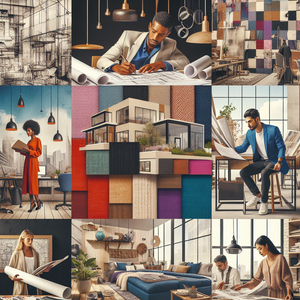
Exploring a Career Shift: 20 Thrilling Paths in Interior Design for Future Designers
Making the leap into a career in interior design is a choice many individuals are making today, driven by a desire to express creativity and redefine their professional journeys. This vibrant field offers numerous opportunities tailored to diverse skill sets and backgrounds, allowing aspiring designers to leverage their previous experiences—whether in project management, customer service, or creative roles. While formal education in interior design can provide a solid foundation, it is often the practical experience, robust portfolios, and mentorship that truly pave the way for success. This article delves into 20 distinct job titles within the interior design landscape, outlining their responsibilities, requirements, and unique contributions. Whether you're just beginning your exploration or looking to pivot your career, this guide will illuminate the various avenues available in this dynamic industry.
Job Summaries:
Interior Designer:
- Interior designers craft functional and aesthetically pleasing environments for clients in residential and commercial settings.
- They engage closely with clients to assess needs and develop design concepts.
- Interior designers create detailed floor plans and source materials.
- They oversee project execution.
- A degree in interior design or a related field is typically required.
- A blend of creative and technical skills is necessary for the role.
- Pursuing certifications from recognized organizations can bolster a designer's credibility.
- This role is ideal for those eager to transform imaginative ideas into real-world solutions.
Interior Design Assistant:
- The role of an interior design assistant is pivotal in supporting lead designers.
- Responsibilities include conducting research, preparing presentations, sourcing materials, and managing timelines.
- This entry-level position generally mandates a degree or coursework in interior design, paired with strong organizational and communication skills.
- Acting as a stepping stone, this position allows aspiring designers to acquire hands-on experience and develop familiarity with the design process.
Freelance Interior Designer:
- Freelance interior designers enjoy the autonomy of managing their projects from start to finish.
- They engage in consultations, project management, and budgeting, often relying on a strong portfolio and established supplier networks.
- Many freelancers begin their careers as assistants or interns, gaining the experience necessary to build both credibility and a diverse client base.
- This path perfectly aligns with the aspirations of those seeking flexibility and independence in their work.
Interior Design Project Manager:
- Project managers in interior design focus on the logistical elements of projects, ensuring they are completed on time and within budget.
- They coordinate with clients, contractors, and suppliers, managing schedules and workflows.
- A background in project management or construction is beneficial, making this role particularly appealing to those transitioning from corporate environments where such skills are honed.
Space Planner:
- Space planners specialize in optimizing layouts to enhance both functionality and aesthetics within various environments.
- They analyze client needs and employ design software to create visualizations.
- A degree in interior design or architecture is preferred, along with proficiency in tools like AutoCAD.
- This position highlights the critical role of strategic planning in interior design, appealing to those with strong analytical skills.
Interior Stylist:
- Focusing on the decorative elements of spaces, interior stylists curate furnishings, artwork, and accessories to create cohesive designs.
- While formal education can be helpful, a keen eye for design, color, and texture is essential.
- This role offers a platform for creative expression, attracting individuals with artistic backgrounds who wish to make a visual impact.
Residential Designer:
- Residential designers work closely with homeowners to create personalized living spaces that reflect their lifestyles and preferences.
- Typically requiring a degree in interior design or architecture, this role is ideal for those passionate about enhancing everyday environments.
- A strong portfolio showcasing past work can significantly bolster a candidacy in this field.
Commercial Interior Designer:
- Specializing in business environments, commercial designers create functional spaces tailored to the needs of offices, restaurants, and retail locations.
- The ability to balance aesthetics with brand identity and practical considerations is crucial.
- A degree in interior design is usually necessary, along with experience in commercial projects, underscoring the versatility of career options within the industry.
Sustainable Interior Designer:
- With an emphasis on eco-friendly practices, sustainable interior designers focus on minimizing environmental impact through the selection of materials and design strategies.
- Knowledge of sustainable practices and a passion for environmental stewardship appeal to many career changers eager to make a positive difference in their new roles.
Interior Design Educator:
- Educators in interior design share their expertise with aspiring designers in academic settings.
- A master's degree in interior design or a related field, coupled with professional experience, is often required.
- This role is perfect for seasoned professionals looking to impart their knowledge and inspire future generations.
- Providing a rewarding avenue for those who find fulfillment in teaching.
Design Consultant:
- Design consultants lend their expertise to clients, helping them clarify their vision and navigate design challenges.
- Strong communication skills and a solid grounding in design principles are essential for success in this role.
- It is particularly suitable for career changers who possess analytical and problem-solving abilities.
Kitchen and Bath Designer:
- Focusing on the heart of the home, kitchen and bath designers create functional and stylish spaces within residences.
- A deep understanding of plumbing, cabinetry, and appliances, combined with a flair for aesthetics, is vital.
- This niche area can be particularly attractive to those passionate about transforming key spaces in homes.
Lighting Designer:
- Lighting designers enhance spaces through thoughtful illumination.
- They select fixtures and create plans that enhance both aesthetics and functionality.
- A background in interior design, architecture, or electrical engineering can be advantageous.
- This specialty underscores the diversity of opportunities within interior design.
- It appeals to those intrigued by the interplay of light and space.
Home Stager:
- Home stagers optimize properties for sale by enhancing their appeal to potential buyers.
- Success in this role requires an understanding of market trends and buyer psychology, as well as a strong design sense.
- While formal education isn’t always necessary, experience in interior design or real estate can be beneficial.
- This role offers immediate impact in the real estate market, ideal for those looking to make a difference quickly.
Furniture Designer:
- Furniture designers craft both functional and artistic pieces that complement interior spaces.
- A deep understanding of materials, manufacturing processes, and design trends is essential for success in this role.
- Typically requiring a degree in industrial design or a related field, this position attracts those eager to contribute creatively to interior environments.
Exhibition Designer:
- Exhibition designers create engaging displays for museums, galleries, and trade shows.
- They conceptualize layouts, select materials, and collaborate with artists to bring ideas to life.
- A degree in interior design, architecture, or a related field is crucial for those wishing to blend art and design.
- Experience in exhibition design is also important.
Historic Preservationist:
- Focusing on restoring and maintaining historical buildings and interiors.
- Historic preservationists ensure that these treasures are preserved for future generations.
- This role requires knowledge of historical architecture and preservation techniques.
- Typically necessitating a degree in architecture, history, or interior design.
- It appeals to those with a passion for history and architecture.
- Providing a deeply fulfilling career path.
Virtual Interior Designer:
- Utilizing technology, virtual interior designers offer remote design services.
- Crafting visualizations and detailed plans.
- Strong technical skills and a foundation in design principles are essential.
- Many in this role enjoy the flexibility to connect with clients around the globe.
- Making it an attractive path for tech-savvy individuals entering the field.
Interior Design Researcher:
- Interior design researchers play a critical role in analyzing trends, materials, and user preferences to inform design practices.
- Often employed by design firms, their insights significantly shape projects.
- A background in design, sociology, or market research is beneficial.
- Appealing to those who enjoy the research aspect of design and aspire to influence its future.
Interior Design Blogger or Influencer:
- Design bloggers and influencers curate content related to design trends and inspirations.
- They share their insights across social media and online platforms.
- Formal education isn’t strictly necessary for this role.
- A strong sense of style, writing skills, and a passion for design are key.
- This role provides a platform for creative expression.
- It can lead to numerous opportunities within the design industry.
As you explore the diverse career paths within interior design, consider how your unique skills and experiences can contribute to this vibrant field. Each of these pathways offers a myriad of opportunities for personal and professional growth, making this an exciting time to embark on your journey in the world of design. Embrace your creativity and let it guide you toward a fulfilling career that not only satisfies your passions but also makes an impact in the lives of others.
Explore More Jobs

